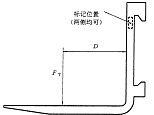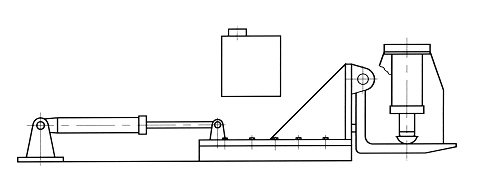Large Tonnage Forks and Their Detection Device
National Construction Machinery Quality Supervision and Inspection Center Chen Baoqiang
I. Introduction
As a critical component of forklifts, forks have gained increasing attention regarding their quality. With the inclusion of forklifts in the category of special equipment, stricter requirements have been imposed on the manufacturing and inspection of forks. The performance of the fork must comply with GB/T 5182-1996 "Technical Requirements and Tests for Forklift Forks." Additionally, forklift trucks exported to the European Union must obtain CE safety certification, and EU coordination standards also require that forks meet ISO 2330:1995 specifications. Although these two standards are largely similar, the testing procedures for large-tonnage forks (with a single fork weight of at least 5000 kg) are quite complex.
Currently, there is almost no domestic detection device available for large-tonnage forks, which makes it difficult to inspect forklift special equipment and export products. To address this issue, the author has developed a fork detection device suitable for loads below 4000 kg and designed a comprehensive testing system for large-tonnage forks based on standard requirements.
II. Preliminary Design of the Testing Device
According to GB/T 5182-1996 and ISO 2330:1995 standards, fork samples must undergo yield tests. For a single fork with a rated lifting capacity of 5000 kg (including 5000 kg), the test load FT should be three times the rated lifting weight C. For a single fork with a rated lifting capacity greater than 5000 kg, the test load FT = G × R, where G is the rated lifting weight coefficient and R = 3 - 0.08(Q - 10), with R ≥ 2.5. The test procedure involves fixing the fork as it would be mounted on a forklift and equipping it with a length gauge to measure permanent deformation. The yield test must be conducted twice without impact, with an interval of about 10 minutes between each load, and each loading duration should last 30 seconds. The loading position is determined by the front surface dimension D of the vertical section of the fork (see Figure 1). When the rated lifting capacity is less than 5500 kg, D represents the load center distance. If the rated lifting capacity is over 5000 kg (including 5500 kg), D refers to the manufacturer's specified value.

Figure 1
III. Composition of the Detection Device and Test Principle:
Based on the standard requirements, the schematic diagram of the fork detection device for 5000 kg or more is shown in Figure 2.
1. The Test Device mainly consists of a loading device, a fork positioning mechanism, a load display unit, a hydraulic system, and measuring devices.
2. Test Principle:
2.1 The fork positioning fork is fixed on the fork frame (which is generally sleeve-type for large-tonnage forks). The fork frame should have a simple structure and a carrying capacity of 100 tons. The pin shaft jacket on the fork frame should come in various specifications to accommodate different fork sizes. The lower positioning block should be adjusted according to the fork's specifications, with different thicknesses chosen accordingly. The forks should be solid and stable, with no deflection, and the upper surface should be level.
2.2 The fork frame is installed on a slide rail, and the front and rear positions of the fork and the frame are adjusted using a cylinder at the tail end to set the load center distance or loading position. Once the correct position is determined, it is locked with a fastening bolt.
2.3 The loading device includes a spherical pressure sensor, a frame, a load display device, and a hydraulic station that powers the cylinder and its rod head. The hydraulic station should provide 20 MPa pressure, with the hydraulic cylinder outputting at least 80 tons. The spherical pressure sensor should have a range of 80 tons, and the display accuracy should be 0.1. A servo cylinder is recommended for the hydraulic cylinder to ensure smooth movement during loading and stable load application.
2.4 After unloading, a length measurement device is installed on the side end of the fork. Measurements are taken before loading (at the fork tip, with the measuring tool parallel to the fork), and again after 30 seconds of loading. This process is repeated after 10 minutes to check for any permanent deformation after two loading cycles.

Figure 2
IV. Determination of the Detection Device Design Plan and Requirements
Currently, the largest tonnage forklift in China is 45 tons. Therefore, the testing device must have a carrying capacity of at least 67.5 tons, which can be set to 80 tons. All brackets, forks, and relevant cylinders must be checked for strength and stability to meet loading requirements. Since the detecting device operates under static load conditions, a smaller safety factor can be used during design.
The hydraulic station must ensure stable output force from the cylinder rod after loading, meaning the hydraulic system’s pressure should remain constant. A servo cylinder should be paired with the hydraulic system to allow the cylinder to follow the fork's elastic deformation and maintain consistent pressure. The hydraulic station should also have fine adjustment capabilities.
The spherical pressure sensor should have a self-aligning function to ensure the load is applied vertically to the top surface of the fork.
The digital load display instrument should monitor the loading condition and be located near the hydraulic station. The test load should be kept stable through a manual hydraulic valve.
The fork frame rail can be processed into a dovetail shape, allowing linear movement of the fork frame and fork when adjusting the load position. Fixing bolts should be evenly distributed for reliable positioning. Due to low longitudinal resistance, a smaller cylinder diameter can be used.
Designing and manufacturing a large-tonnage fork detection device will expand the scope of fork testing, fill the gap in domestic large-tonnage fork detection, and add testing equipment for parts inspection in large-tonnage fork type tests, providing essential experimental support for forklift product exports.
Stretch And Winding And Packing Film
Stretch And Winding And Packing Film,Pe Stretch Wrap Film,Pe Stretch Film,Stretch Pe Winding Film
Wuxi Xinhao Protective Film CO.,Ltd , https://www.cotton-balewrap.com